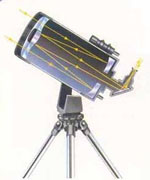Telescopes generally come in three flavors (types): refractors, reflectors, and catadioptrics.
Reflector telescopes use mirrors (and an eyepiece) to view celestial targets. Mirrors are much less expensive to produce than lenses, so an 8" reflector costs about the same as a 3" apochromatic refractor, and will bring in nearly 6 times as much light. Unlike some refractors, mirrors do not suffer from chromatic abberation.
Reflectors rely on a small "secondary" mirror to direct the image from the large curved primary mirror to the focuser/eyepiece. The secondary blocks some of the light that would otherwise enter the telescope. An 8" ($500) reflector will effectively gather as much light as a 7" ($10,000) refractor. Also, the secondary mirror (very) slightly reduces the clarity of the image.
Due to their open design, reflectors need to be cleaned and adjusted (collimated) much more often than other types of scopes. This maintainance is relatively simple, but it must be done regularly to ensure a good image. A six or eight inch reflector is a great scope for a beginning observer, and can be used for photography with an appropriate mount.
Advantages - low cost (best bang for your buck!)
Disadvantages - need frequent adjustments and cleaning
 The third major telescope design (catadioptric) uses mirrors and lenses to focus the light beam. Understandably, these scopes are intermediate in price to the refractors and reflectors. Schmidt-Cassegrains (aka SCTs) are the most common type of catadioptric scope. They are the Swiss Army Knives of telescopes - useful for many types of configurations. Light is folded numerous times in these scopes resulting in high magnification in a short design. Only occasional adjustments are needed to keep these scopes in collimation. SCTs use a secondary mirror, so like reflectors, there is a very slight loss in the sharpness of images, and a reduction of roughly 25% in the light that makes it through to the primary mirror. The use of a primary mirror means there is no chromatic abberation.
The third major telescope design (catadioptric) uses mirrors and lenses to focus the light beam. Understandably, these scopes are intermediate in price to the refractors and reflectors. Schmidt-Cassegrains (aka SCTs) are the most common type of catadioptric scope. They are the Swiss Army Knives of telescopes - useful for many types of configurations. Light is folded numerous times in these scopes resulting in high magnification in a short design. Only occasional adjustments are needed to keep these scopes in collimation. SCTs use a secondary mirror, so like reflectors, there is a very slight loss in the sharpness of images, and a reduction of roughly 25% in the light that makes it through to the primary mirror. The use of a primary mirror means there is no chromatic abberation.
Advantages - size, utility
Disadvantages - more expensive than reflectors, very minor contrast loss due to secondary mirror.
The Telescope in Your Closet
 Many people overlook a great little telescope that's probably sitting in a closet, a drawer, or out in the garage right now - binoculars! Binoculars are great observing tools for beginning and experienced astronomers. They give wonderful views of the moon, star clusters, and even some nebulas and galaxies. Before you rush out to spend hundreds or thousands of dollars on a big telescope, spend a little time with some binoculars.
Many people overlook a great little telescope that's probably sitting in a closet, a drawer, or out in the garage right now - binoculars! Binoculars are great observing tools for beginning and experienced astronomers. They give wonderful views of the moon, star clusters, and even some nebulas and galaxies. Before you rush out to spend hundreds or thousands of dollars on a big telescope, spend a little time with some binoculars.

